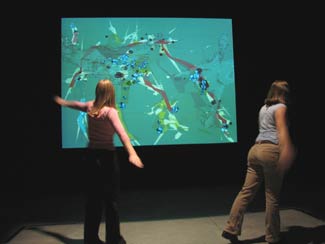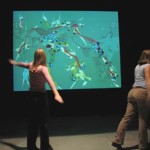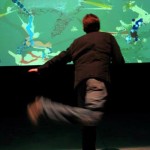By MATTHEW NASH
Sometimes it seems as if there is a deep divide in the ways we discuss art in our current moment. On one hand, there is a form of dialogue that begins with ideas and intentions, exploring how the artist translated those through their media and how successful that statement was made. This type of conversation involves theory, conceptual practice and an understanding of the discursive nature of contemporary art; it is also the primary mode of consideration for much of the work in the Boston Cyberarts Festival.
On the other hand, there is a more traditional discourse around work that evokes the artist's hand, exploring gesture and form, color and texture. This vocabulary comes from the “fine art” histories of drawing and painting, and is a starting point for much understanding and appreciation of art.
It seems like these kinds of conversations rarely overlap, or that the primacy of one set of interests dominates the conversation. Yet, it is this divide that Camille Utterback tries to bridge in her new work “Animated Gestures” at Art Interactive.
Given that this work is a part of the Cyberarts Festival, it seems fair to assume that most viewers begin their experience considering the technology and concepts, before moving on to the more painterly aspects of the work. Certainly the technology is foregrounded in the presentation, as viewers interact with the work by passing through illuminated squares and the floor. The shadow they cast appears within an image projected nearby, and their shape begins to change the “surface” of the work.
There are three pieces in the space, on four screens. The dual-screen piece presents two dark blue surfaces, covered with a sort of digital sand. Movement through the activated floor of one screen adds “sand” to one screen while removing it from the other; changing floor spaces reverses the process.
The other two screens present colored fields, and by passing through their illuminated floor the viewer creates new “marks” across the surface of the image. Both pieces seem to function in the same way, with the variation being the kinds of “marks” made through interaction.
Interacting with the work through the movement of one’s body ensures that the idea of “gesture” is not understated; the resulting “marks” are designed to be very “painterly” and the overall effect implies an updated version of Jackson Pollock’s process. What is missing is the physical interaction with the work, the “mark-making” and “gestural” qualities that are associated with abstract art; but what is gained is an experience that questions why the two modes of dialogue need to be so separate and exclusive.
Ultimately, it’s hard to tell whether the work is successful at bridging the gap between what we expect of painting versus our expectations of technology. Given that the technology is so present in the work, it is hard to get past the interactive nature and see the painterly intentions. Similarly, considering that “gesture” has long been associated with the artist’s hand, the distance between the “hand” and the “mark” that is exaggerated in this work might call extra attention to the very divide Utterback is attempting to bridge. At the same time, it is that exaggeration that asks us to consider why there cannot be any "mark" in interactive work, and forces us to evaluate our expectations of the creative process and the experiences derived from considering both "traditional" and "new media" artwork.
“Animated Gestures” is a fun and seemingly simple show that asks a lot of tough questions about art and technology. It is the kind of work we have come to expect from Art Interactive, and in attempting to unite two forms of dogma successfully challenges them both.
- Three views of the interactive work by Camille Utterback, and viewers engaging with the work.
"Animated Gestures" is on view March 9 - May 13, 2007 at Art Interactive.
All images are courtesy of the artist, Art Interactive and The Boston Cyberarts Festival.
Images found at the Boston Cyberarts website.







